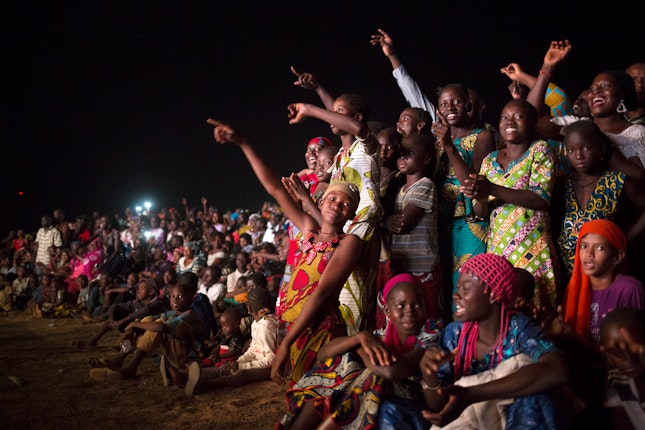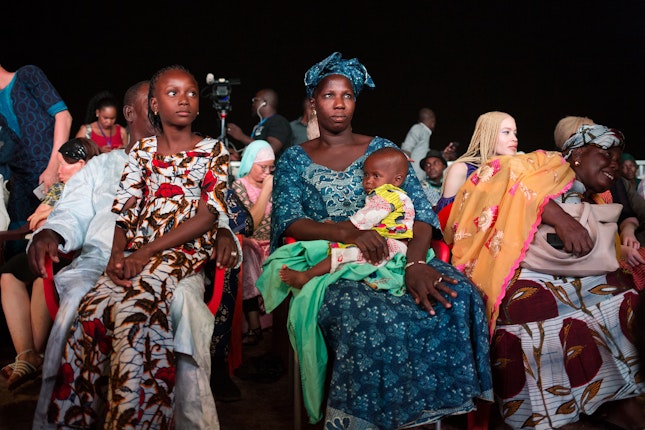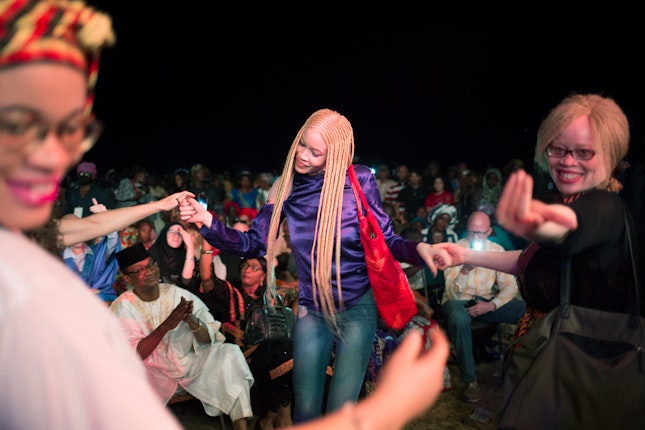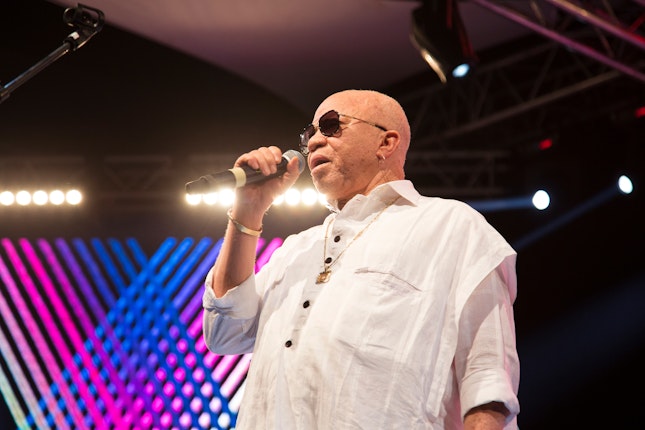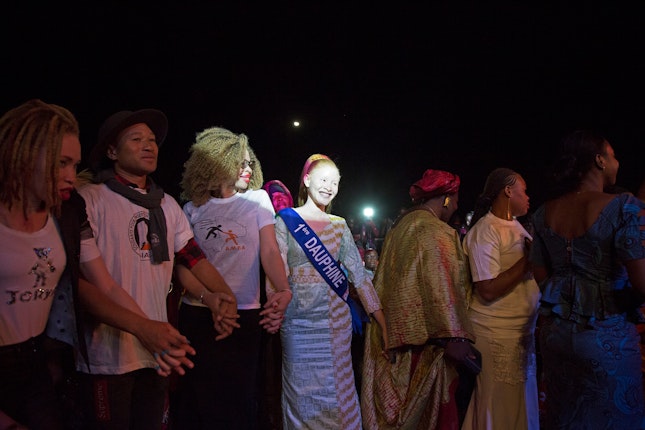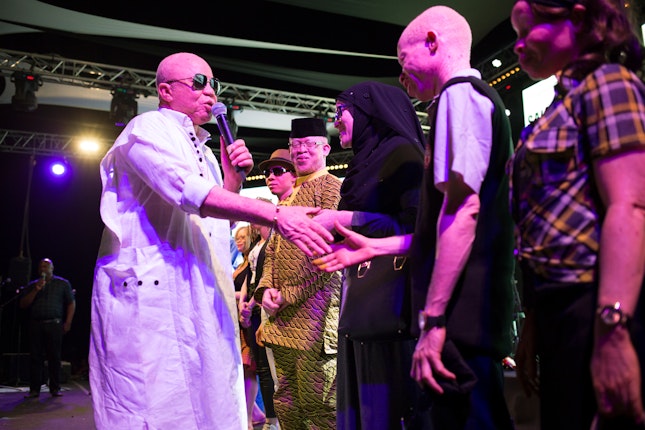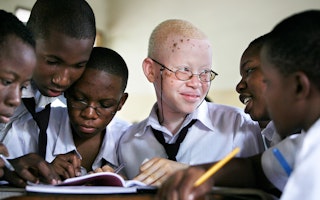“We Are Tired of Being Ignored”
In Depth
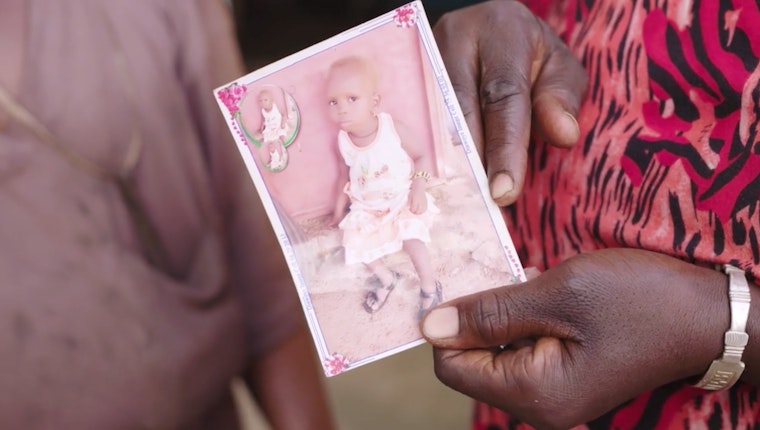
Following a brutal murder in Mali, one of Africa’s most celebrated artists helped rally a movement to defend the rights of people with albinism, and organized a defiant musical festival unlike anything the world had ever seen.
Hawa Touré, a mother of five, woke with a start. In the dark, she felt for her children.
It was Mali’s dry season. She had been sleeping in the yard of their home with her family to find relief from the heat. Ramata, her five-year-old daughter, was gone.
In that instant, Hawa would say later, she knew what had happened—even before she spotted a man leaping over the small fence that borders their property with her daughter under his arm.
The taking of this little girl would soon focus international attention on Fana, the family’s hometown, a barely-on-the-map community 78 kilometers from Bamako, Mali’s capital. The incident would also play a role in the country’s heated presidential campaign—and eventually lead to a loud, unprecedented public display of solidarity for a group of people who face deep discrimination and rarely receive attention.
Ramata had albinism, an inherited condition that can prevent pigmentation, or coloration, of the skin, hair, and eyes. She was not yet old enough to attend school, so she had been sheltered from much of the bullying and daily harassment that many people with albinism in Africa face.
It is not uncommon, for example, for people in Mali to spit when they come across a person with albinism, as a way to express their disgust.
“It is a terrible thing to say, but we are seen by some as nonhuman,” explains Ikponwosa Ero, the UN Independent Expert on the Enjoyment of Human Rights by Persons with Albinism. Ero, a Nigerian, also has albinism.
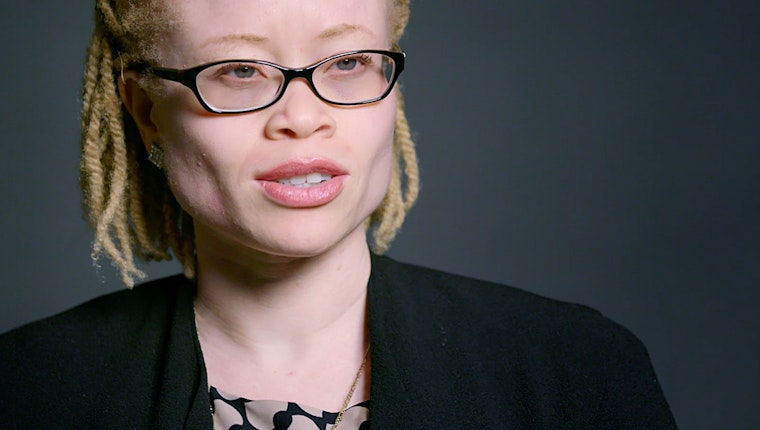
People with albinism live all over the world, but are more concentrated in parts of Africa. In the United States and Europe, approximately one in twenty thousand persons has albinism. In some communities in Africa, the ratio is one in a thousand.
For centuries, people in Africa struggled to explain why the skin color of some babies was drastically different than the skin color of their parents. Over time, many myths took root. The idea that the birth of a child with albinism was a supernatural sign of bad luck became commonplace in parts of western, eastern, and southern Africa. The body parts of people with albinism—their hair, their skin, their teeth—have become prized ingredients in witchcraft potions intended to bring strength, riches, and even favorable election results.
Thanks to these beliefs, a lucrative, illegal trade in body parts has sprung up. As a result, in many communities, people with albinism are called “money.” A single tooth of a person with albinism reportedly sells for several hundred dollars, an intact limb can fetch several thousand dollars, and a full corpse goes for as much as $75,000.
Ramata’s mother knew that assailants hoping to carry off body parts of people with albinism were attacking with increasing frequency. She chased the man who took her daughter. But in the darkness, it was difficult to tell which way he had gone. Ramata’s body was discovered by neighbors later that night, just a few hundred meters from her home. She was decapitated. As of this writing, her head has not been found.
Albinism is a recessive trait, like blue eyes. There is a great deal of misunderstanding about what causes the condition.
Many people do not understand that both the mother and the father must carry the gene for it to be inherited.
When Salif Keita, a musician nominated for multiple Grammy awards, was born almost 70 years ago in a small village south of Bamako, his father shrieked in horror. “What is this thing?” he asked.
Keita, born to two black-skinned parents, had white skin.
Today, Keita—often referred to as the “Golden Voice of Africa”—is probably the best-known person with albinism in the world. Appearing onstage regularly in his trademark white tunic, or “boubou”; white shoes; and a white cap, he regularly plays sold-out concerts from Nairobi to New York.
On the night Ramata was killed, Keita was in Bamako, at work on a final album as a capstone to a successful, if unlikely, music career.
“I always wanted to be a teacher,” Keita explained recently in a conversation on Djataland, a small island he owns in the Niger River, outside Bamako. “But they pulled me aside the day before I was to graduate and told me I would never teach. They thought my white skin would scare the students.”
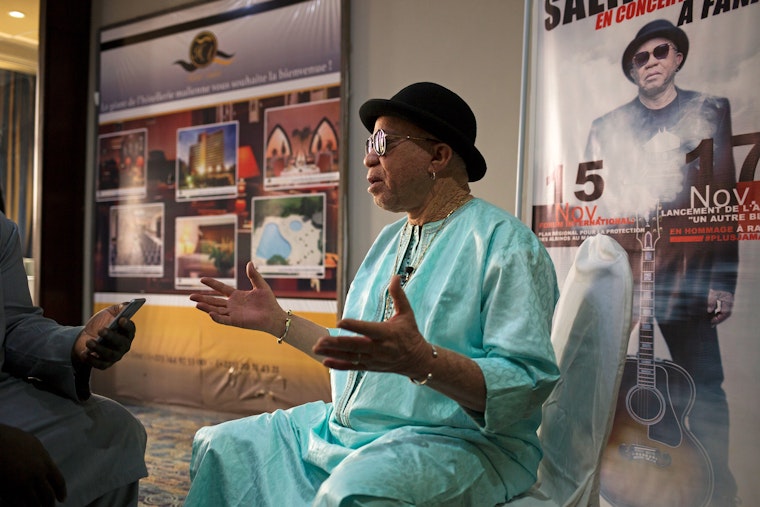
Denied an opportunity to teach, Keita turned to the guitar. “I used to sing to scare away the monkeys and keep them from eating the crops on my family farm,” he explained. He moved to Bamako, playing music on the street and in bars. Keita, widely credited as a founder of Afro-Pop, had a knack for blending traditional African music with international styles. He quickly became a star.
Over time, he explained, he came to see albinism as a gift.
“It gives me the perspective I have today,” he said. “It has made me who I am.”
Using his celebrity, Keita has worked to advance the rights of people with albinism, establishing the Salif Keita Global Foundation in Bamako in 2006. The musician is so well-known for his advocacy on behalf of people with albinism that many Malian newspapers ran photos of Keita next to their stories about the attack, even though his only connection to the story, at that time, was that he also has albinism.
Soon after Ramata’s death, Keita took the two-hour drive to Fana to meet with her family. He kept apprised of the investigation into the girl’s death and was unhappy with what he learned.
The murder, according to advocates on behalf of the rights of people with albinism, was not properly investigated. A neighbor was arrested, but many were skeptical; if he was responsible for the crime, they doubted he had acted alone. If there were connections to moneyed elites and the witch doctors who serve them, they were apparently not explored.
“We believe the investigation is very poor,” said Mamadou Sissoko, the Secretary General of Federation of Associations of Persons with Albinism in West Africa. “The deeper questions have been ignored. Who is behind these killings? What can be done to protect the community of people with albinism in Mali? From the government we hear nothing.”
Advocates have grown accustomed to such foot-dragging in investigations into attacks on people with albinism. Ero, the UN official, sees similar challenges across the continent.
“Deep-seated discrimination and fear prevents many investigations from going forward,” she says.
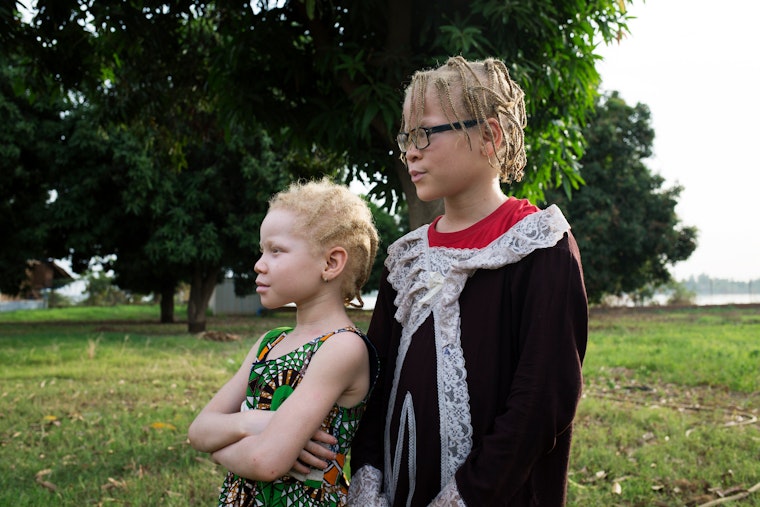
Authorities—possibly due to their own biases against people with albinism or their lack of understanding of the nature of these crimes—do not aggressively pursue investigations, experts say. Witnesses do not come forward on behalf of people they see as “subhuman” or inconsequential. And people with albinism sometimes fear a backlash and further stigmatization if they speak out.
Some see a darker motivation that prevents a full investigation of the perpetrators of these sorts of crimes.
“Investigators are afraid of what they might find,” says Keita.
“When you ask who is paying for these body parts?” Ero, who has led fact-finding missions in several African countries, examining attacks and their aftermath, says. “The answer is, it is mostly business and political elites on the demand side.”
Keita had an idea—a way to use his celebrity to try to focus attention on the killing, the inaction in its aftermath, and the discrimination underlying it all. “The attitude should be ‘never again,’” he explains. “We must do all we can do to ensure this never happens again. Never, ever again.”
While Ramata’s killing was tragic, it was also—in a twisted way—unsurprising.
The attack took place in May 2018, a particularly complicated time in Mali.
A yearslong insurgency in the north was dragging on, and extremist groups from al-Qaeda and the Islamic State were making headlines by periodically shooting rockets into UN peacekeeping bases.
The crushing poverty (half of Mali’s 18 million people live on less than $2 a day), the violence, and reports of corruption created a sense that the president, Ibrahim Boubacar Keita (no relation to Salif Keita), was politically vulnerable. In the July elections, more than two dozen people launched campaigns to unseat him. A number of other important local and regional elections were also on the ballot.

“Election season is often a dangerous time for people with albinism,” Ero says. “Some business and political elites are motivated during these times to do whatever it takes, to ensure they get the result they want.”
Many believe that Ramata was “sacrificed” in a ritual killing connected in some way to the elections that were taking place two months later.
Ero’s office has information on roughly 700 attacks across the continent against people with albinism that have taken place since 2009. The majority targeted children. Some believe their innocence “enhances the potency of the witchcraft ritual,” according to a 2013 UN report.
Reported Attacks Against People with Albinism Across Africa
Types of Attacks
| Murders | ||
| Assaults | ||
| Child Abandonment | ||
| Grave Robberies | ||
| Missing |
Attacks in Benin |
|
| Murders | 5 |
| Assaults | 5 |
| Child Abandonment | - |
| Grave Robberies | - |
| Missing | 6 |
Attacks in Botswana |
|
| Murders | - |
| Assaults | 3 |
| Child Abandonment | - |
| Grave Robberies | - |
| Missing | 6 |
Attacks in Burkina |
|
| Murders | 2 |
| Assaults | 6 |
| Child Abandonment | - |
| Grave Robberies | - |
| Missing | - |
Attacks in Burundi |
|
| Murders | 21 |
| Assaults | 13 |
| Child Abandonment | - |
| Grave Robberies | 4 |
| Missing | - |
Attacks in Cameroon |
|
| Murders | 2 |
| Assaults | 2 |
| Child Abandonment | - |
| Grave Robberies | 1 |
| Missing | - |
Attacks in DRC |
|
| Murders | 17 |
| Assaults | 35 |
| Child Abandonment | - |
| Grave Robberies | 9 |
| Missing | 1 |
Attacks in Ghana |
|
| Murders | 1 |
| Assaults | 2 |
| Child Abandonment | - |
| Grave Robberies | - |
| Missing | - |
Attacks in Guinea |
|
| Murders | 5 |
| Assaults | 6 |
| Child Abandonment | - |
| Grave Robberies | - |
| Missing | - |
Attacks in Ivory Coast |
|
| Murders | 9 |
| Assaults | 13 |
| Child Abandonment | 2 |
| Grave Robberies | - |
| Missing | 4 |
Attacks in Kenya |
|
| Murders | 5 |
| Assaults | 8 |
| Child Abandonment | - |
| Grave Robberies | - |
| Missing | - |
Attacks in Lesotho |
|
| Murders | 1 |
| Assaults | - |
| Child Abandonment | - |
| Grave Robberies | - |
| Missing | - |
Attacks in Madagascar |
|
| Murders | 1 |
| Assaults | - |
| Child Abandonment | - |
| Grave Robberies | - |
| Missing | - |
Attacks in Malawi |
|
| Murders | 16 |
| Assaults | 21 |
| Child Abandonment | - |
| Grave Robberies | 5 |
| Missing | 3 |
Attacks in Mali |
|
| Murders | 5 |
| Assaults | 3 |
| Child Abandonment | - |
| Grave Robberies | - |
| Missing | 2 |
Attacks in Mozambique |
|
| Murders | 15 |
| Assaults | 13 |
| Child Abandonment | - |
| Grave Robberies | 5 |
| Missing | 13 |
Attacks in Namibia |
|
| Murders | 2 |
| Assaults | 1 |
| Child Abandonment | - |
| Grave Robberies | - |
| Missing | - |
Attacks in Niger |
|
| Murders | - |
| Assaults | - |
| Child Abandonment | - |
| Grave Robberies | - |
| Missing | 1 |
Attacks in Nigeria |
|
| Murders | 4 |
| Assaults | 2 |
| Child Abandonment | 0 |
| Grave Robberies | 0 |
| Missing | 1 |
Attacks in Rwanda |
|
| Murders | - |
| Assaults | - |
| Child Abandonment | - |
| Grave Robberies | 1 |
| Missing | - |
Attacks in Senegal |
|
| Murders | 3 |
| Assaults | 4 |
| Child Abandonment | - |
| Grave Robberies | - |
| Missing | - |
Attacks in South Africa |
|
| Murders | 4 |
| Assaults | 2 |
| Child Abandonment | - |
| Grave Robberies | 1 |
| Missing | 2 |
Attacks in Swaziland |
|
| Murders | 4 |
| Assaults | 7 |
| Child Abandonment | - |
| Grave Robberies | - |
| Missing | - |
Attacks in Tanzania |
|
| Murders | 76 |
| Assaults | 80 |
| Child Abandonment | - |
| Grave Robberies | 22 |
| Missing | 1 |
Attacks in Togo |
|
| Murders | 1 |
| Assaults | - |
| Child Abandonment | - |
| Grave Robberies | - |
| Missing | - |
Attacks in Uganda |
|
| Murders | - |
| Assaults | 8 |
| Child Abandonment | - |
| Grave Robberies | - |
| Missing | - |
Attacks in Zambia |
|
| Murders | 6 |
| Assaults | 5 |
| Child Abandonment | - |
| Grave Robberies | 2 |
| Missing | - |
Attacks in Zimbabwe |
|
| Murders | 1 |
| Assaults | 1 |
| Child Abandonment | - |
| Grave Robberies | - |
| Missing | - |
All information on killings and attacks are gathered by Under the Same Sun—an organization that supports people with albinism—through its field work and research including reports from media, families of victims, and other albinism advocacy and service groups. Under the Same Sun notes that for a number of reasons there are killings and attacks that are likely never reported. This is due to limited press capacity and freedoms in many countries where these atrocities take place. It also is tied to biases carried by some local leaders and police who do not view attacks on people with albinism as being worthy of investigation and/or justice. But also, and more fundamentally, many of these cases are not widely known about because the killing of babies with albinism is a long tradition, extending—as Under the Same Sun notes—“before memory.” Mothers and fathers abandon, and even smother, their own children. News of this sort of family-on-family violence does not often reach far.
Advocates on behalf of people with albinism in Mali can list the names of children who were attacked in Mali going back decades. Keita says that when he was growing up, the fear of “being sacrificed” was a regular presence in his life.
The killings themselves are often gruesome. In 2005, the tongue of a four-year-old in Mali was severed “to sprinkle a fetish with blood that would bring good luck,” according to a Malian investigator interviewed at the time by the Wall Street Journal.
In response to these atrocities, some countries have taken meaningful action. Five African nations—Nigeria, Kenya, Tanzania, Mozambique, and Malawi—have adopted comprehensive plans intended to bolster the security of people with albinism.

Keita and other activists want Mali to do the same. They have urged training for local and national police, site visits to the homes of people with albinism to see if simple upgrades could enhance their security, and the designation of a task force to investigate attacks.
If some of these low-cost solutions had been in place, experts say, Ramata would likely still be alive today.
Advocates say a comprehensive plan should also include remedies for other threats to people with albinism. The largest of these is the sun. Ninety percent of people with albinism who live in sub-Saharan Africa die before the age of 40 due to skin cancer. There is a simple solution: provide sunscreen, at low cost, to those who need it.
A comprehensive plan to help people with albinism would include such a provision, advocates say, as well as a robust public education program to ensure that potential beneficiaries knew where to get sunscreen, how to apply it, and why it was necessary.
“We are tired of being ignored,” explains Sissoko. “We want the government to fulfill their obligations so that people with albinism are able to live full, dignified lives.”
Fana, a town of 24,000 people, is known as a place to fuel up on the road to the North, where the insurgency is still underway.
The Sahara Desert is only a few dozen kilometers away. Once you leave the central paved highway, most of the roads are a packed brown earth.
Keita decided to release his final album—Un Autre Blanc (Another White)—here, in Ramata’s hometown, to focus attention on her death.
As Coumba Makalou—Keita’s wife, the president of his foundation, and a driving force behind organizing the concert and the events around it—explained, it was an improbable choice: “People don’t often play benefit concerts in Mali. And they certainly don’t play them in small towns with limited electricity.”
But in playing his show in Fana, Keita hoped to force a response from the government.
“Music is like a knife,” Keita explained. “It’s a weapon that can be used to fight back.”
Keita envisioned a massive benefit concert on the packed sand.
In the months leading up to the show, Keita and his team set up a massive generator on the town’s soccer pitch. And they built a 150-foot-wide stage, with a video screen backdrop capable of showing images three stories tall.
Keita, and other advocates, also planned three days of events in the run-up to the concert to focus on the challenges people with albinism in Africa face.
In the run-up to the show, the Salif Keita Global Foundation brought advocates from more than a dozen African countries to Bamako in order to discuss which practices employed by governments to protect the rights of people with albinism worked best.
Speaking Out on Albinism in Africa
Advocates attending the Forum for Action on Albinism in Bamako, Mali, discuss their personal experiences. The forum took place in the run-up to the benefit concert in Fana organized by the Salif Keita Global Foundation.
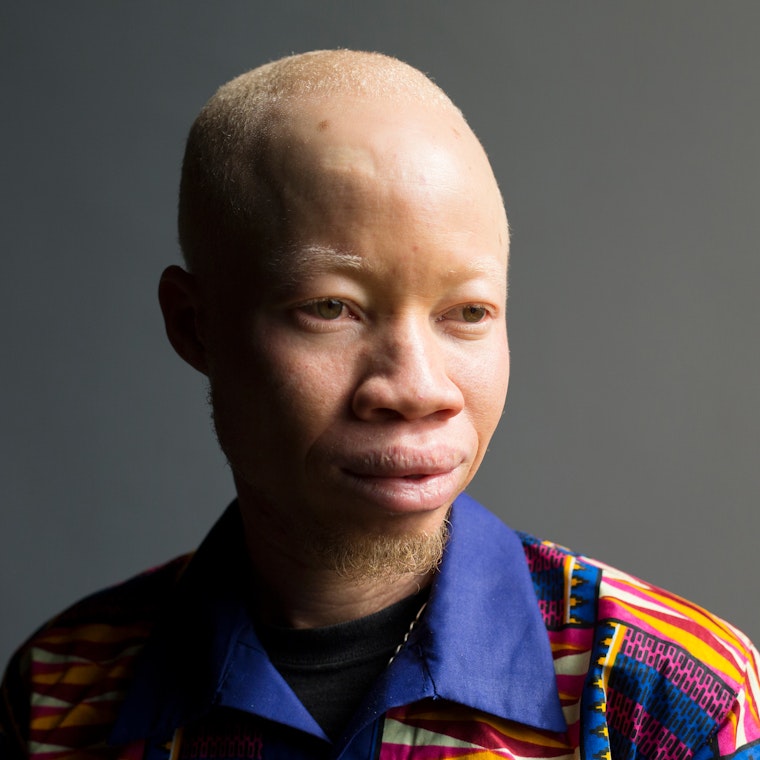
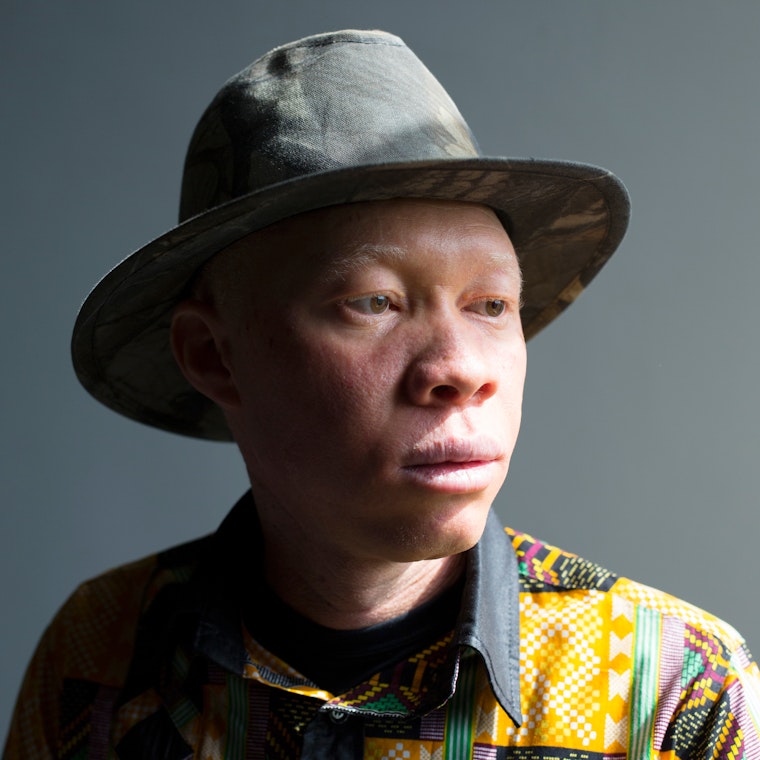
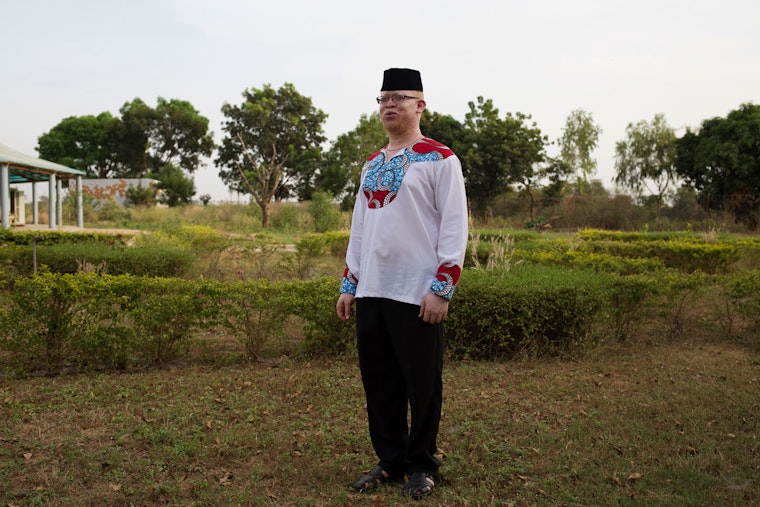
Mohamed Sesay (top left) is a soccer commentator and a member of the Sierra Leone Association for Persons with Albinism.
Mohamed Osman Camara (top right) is a college student in Sierra Leone and a member of the Sierra Leone Association for Persons with Albinism
Isaac Mwaura (bottom) is the first person with albinism ever to be elected to Kenya’s parliament.
© Annie Risemberg for the Open Society Foundations
“We are not black enough to be considered Black, not white enough to be considered white, and not disabled enough to be considered disabled.” —Isaac Mwaura
At a daylong forum, Senator Isaac Mwaura—the first person with albinism to ever be elected to Kenya’s parliament—spoke to a crowd of approximately 100 diplomats, UN officials, and advocates. He explained how his country had marshalled more than $1 million in funding to launch an awareness campaign that helped debunk many myths surrounding albinism. One of their key initiatives: a beauty pageant intended to send a message that people with albinism are to be celebrated, rather than kept out of sight. (The fund is also used to supply sunscreen at hospitals around the country.)
Mwaura explained that people with albinism often feel isolated.
“We are not a part of a larger community,” he said. “We are not black enough to be considered Black, not white enough to be considered white, and not disabled enough to be considered disabled.”
The Salif Keita Global Foundation also sponsored a health screening on the island Keita owns. Dozens of people with albinism, mostly mothers with children, lined up for a free exam from Dr. Aisha Sethi, an associate professor of dermatology at Yale University, who had flown to Mali to support the foundation’s efforts.
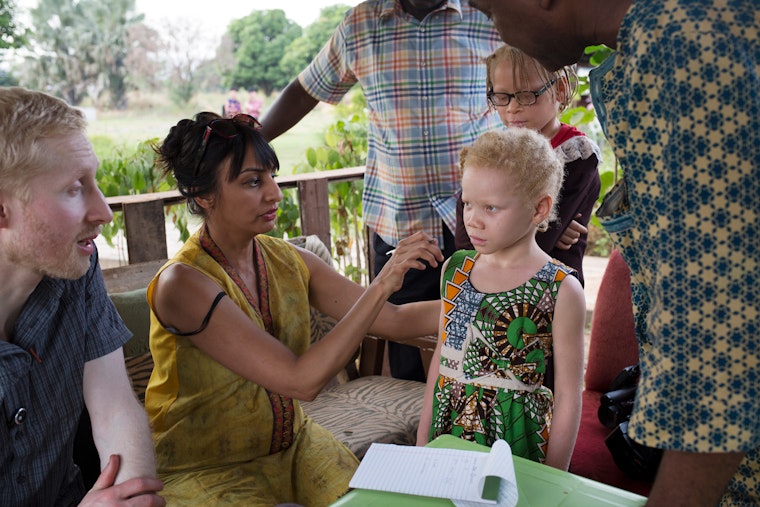
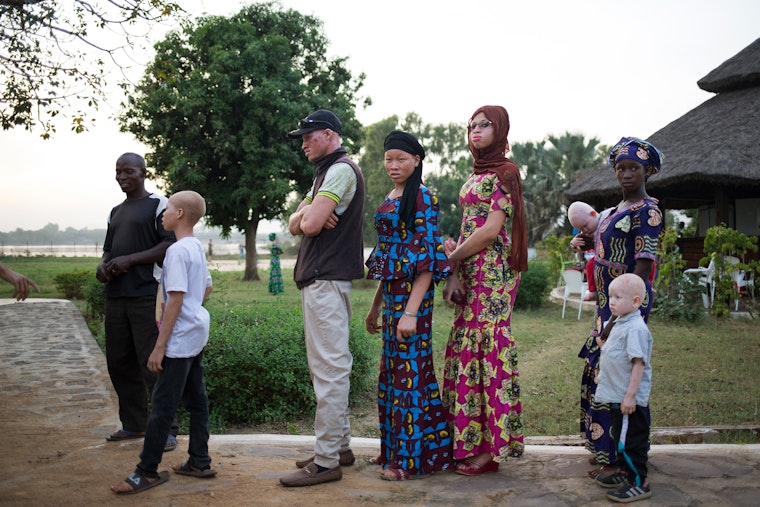
One child, age 14, joined the line wearing a hood, which partially obscured his face. When it was his turn to visit the doctor, he took his hood off, revealing an enormous, multi-colored cancerous growth on his cheek. Sethi immediately scheduled an appointment for him to see a specialist in Mali for help.
“This is hard to see,” said Makalou, Keita’s wife, adding that many people with albinism don’t know how to protect themselves from the sun, and those suffering from skin cancer don’t know where to turn for treatment.
Several times a year, she said, people with these sorts of growths show up at the doors of their foundation. “They don’t know what else to do, or where else to go,” Makalou added. “But by then, it is often too late.”
The concert honoring Ramata was the largest event ever celebrating albinism. An estimated 20,000 to 35,000 people attended.
The vast majority arrived on foot, by bike, or by public transport.
“This was not supposed to be about, and for, elites. It was for the people of Fana,” said Makalou. “We wanted to have an event that gave a chance for the community impacted by this crime, to express how they felt.”
The crowd pressed against the security barriers a few dozen feet from the stage. In front, a section was reserved for people with albinism and other disabilities.
Ramata’s family—her mother, father, brothers and sisters—sat in folding chairs in the first row, a few feet from the stage. Her mother, wearing a colorful turban that matched her dress, told Reuters before the show, “I will always have this pain in me.” She watched quietly—her infant son in her lap—as some of Mali’s best-known musicians, comedians, and celebrities invoked Ramata’s name and called for justice.
At times, the atmosphere resembled a large political rally. There were poems, songs, and speeches about the need for action. Many people wore T-shirts saying: “I am Ramata.” The crowd chanted, “Never again!”
At 11:30 p.m., Keita took the stage to wild applause and a burst of white lights, as thousands used their phones to take flash pictures of the musician playing a concert in Mali—likely for the last time.
The supermodel Diandra Forrest, who had flown to Mali from New York City for the event, joined Keita on stage to dance. Between songs, Forrest, who has albinism, explained that she “made it [her] life’s mission” to advance the rights of people with albinism.
“Diandra is an inspiration to many girls with albinism,” Makalou explained. “Just seeing her, and knowing her story, can be life changing for them.”
Keita invited people with albinism from the crowd to join him on stage for the last song, a version of his hit “La Différence.”
As approximately 75 people with albinism—including a man so old he could barely navigate the six steps up to the stage—danced with unrestrained joy, Keita sang: “I am a black. My skin is white. And me, I love that. It’s the difference that is beautiful.”
National and international media captured the scene. Footage from the events was played so often by Mali TV that when Senator Mwaura from Kenya got in a taxi later, the driver said, “Didn’t I see you on the news?”
“Salif’s concert is a cry from the heart to make reason heard.” — Hawa Touré
It was a rare moment under the bright lights for a group of people who often live in the shadows, too scared, too harassed, and too vilified to experience life’s most basic routines—going to school, getting a job, getting married—in peace.
As one activist who attended the event said, “Tonight, being a person with albinism is pretty cool.”
When the concert had ended, as the crowd of thousands began walking home, Ramata’s mother said she was grateful to Keita and others for everything they had done. If people with albinism are “seen as human beings,” she said, “it becomes a fact. Salif’s concert is a cry from the heart to make reason heard.”

There is evidence that some have begun to listen.
Mali government officials contacted Keita after the concert and gave advocates reason to hope that they are now taking their responsibility to safeguard the rights of people with albinism more seriously. A representative from the Justice Ministry has also been tapped to stay up-to-date on developments in Ramata’s case.
Advocates say that because of the courage of Ramata’s family, they have a special obligation to continue their efforts.
“In some ways,” Makalou said, “all of this has caused the family’s wound to remain raw. Their great courage has made it possible for many more to benefit in the future. It’s up to us to make good on that promise.”
Until September 2022, David Danzig was a senior communications officer at the Open Society Foundations.
Text: David Danzig
Audio interviews: Azmi Haroun

